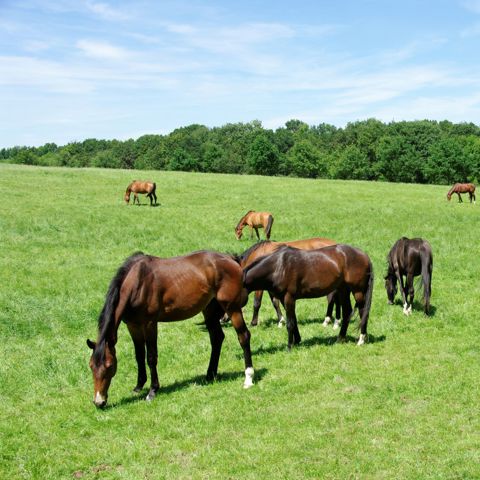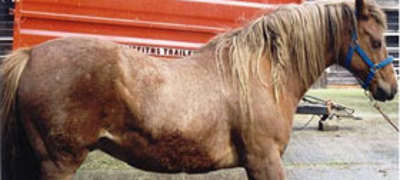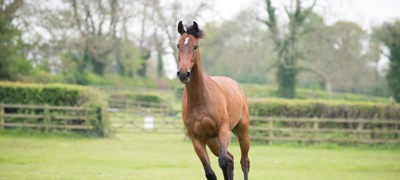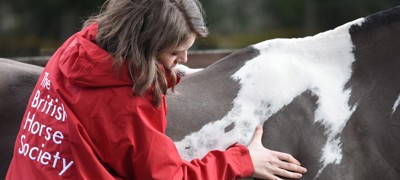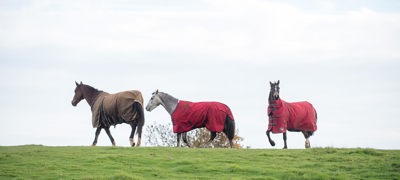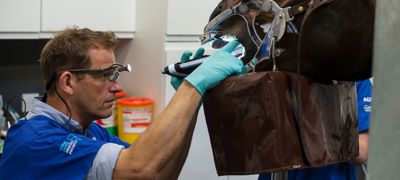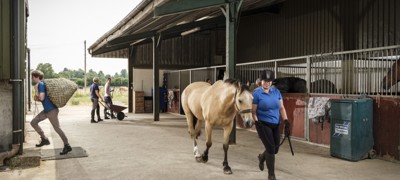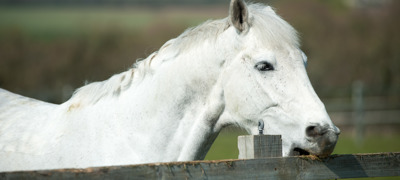All horses and ponies are at risk of EMS, however it’s most commonly seen in overweight equines1. The main disorder of EMS is insulin resistance, which means the horse is also at greater risk of laminitis and many other complex disorders2.
Advice specific for donkeys is available from The Donkey Sanctuary.
What is EMS in horses?
Horses with EMS are unable to regulate blood insulin levels. EMS is characterized by a combination of three key features:
- Insulin dysregulation
- Being overweight or regional abnormal fat deposits (known as adiposity)
- Increased risk of laminitis
Signs of EMS in horses
The development of abnormal fat deposits (sometimes described as pockets/bulges/pads) usually seen around the crest, behind the shoulder, the hind quarters (especially at the tail head) and above the eyes, is one of the most common signs of EMS. However, some horses and ponies may still be suffering with insulin dysfunction even if they’re at a healthy weight3.
Other signs can include:
- Difficulty losing weight
- Recurring episodes of acute laminitis
- Increased drinking and urination
- Lethargy (lack of energy)
- Infertility in mares has been associated with EMS4

Photo credit: Blue Cross. Image shows pony with unusual fatty deposits across body.
The role of insulin
chevron-down
chevron-up
Insulin is a hormone that’s needed to regulate blood sugar (glucose) levels. Glucose is taken from the bloodstream to be used as fuel (for example, movement of muscles) or stored as fat. Therefore, insulin has the important task of regulating glucose metabolism.
However, for horses with EMS, problems occur when hormones produced by excessive fat cells prevent insulin from carrying out its vital task, leading to insulin resistance and elevated blood sugar levels. The body responds and starts to compensate by producing more insulin which ends up circulating in the horse’s bloodstream, known as hyperinsulinemia.
It’s because of these hormonal changes that EMS is commonly linked to causing laminitis, although the exact mechanisms of how this happens are not yet fully understood2.
Diagnosis
chevron-down
chevron-up
Diagnosing and managing EMS is key to preventing chronic, recurrent laminitis.
Along with observing the common signs of EMS, blood tests can be used to diagnose EMS in your horse. Your vet will take blood samples to measure insulin and glucose levels in the bloodstream2. If high levels of both substances are detected, this is a clear sign of EMS.
If you suspect your horse is suffering from EMS, speak to your vet for further guidance.
Treatment
Weight management
chevron-down
chevron-up
The good news is that EMS can be reversed. However, due to the complex nature of EMS, there is likely to be weight loss resistance. This can be disheartening for horse owners, so it’s vital to seek the support of your vet, nutritionist, and, if you have lessons, a BHS Accredited Professional Coach to help tailor an individual plan to meet your horses’ specific needs.
Reducing calorie intake and increasing physical activity are key to treating EMS by reducing weight and improving insulin sensitivity1,2.
Exercise programme
chevron-down
chevron-up
Exercise significantly improves glucose uptake by muscles and decreases blood sugar levels. However, exercise can be limited in horses with EMS if they have acute or chronic active laminitis. Ideally, as soon as the horse is comfortable and with veterinary advice, a controlled exercise programme can begin. The exercise should be tailored to the individual horse, considering their level of fitness, current condition, age and the facilities available to you.
Medication and supplementation
chevron-down
chevron-up
A variety of medications and EMS supplements are also available, and it’s best to discuss these options with your vet.
Prevention
Due to overweight horses being more likely to develop EMS, keeping your horse at a healthy weight is important to help decrease the risk.
Tips to keep your horse at a healthy weight:
You can use a weigh tape and get hands-on by fat scoring (also known as body condition scoring) to monitor your horse’s weight closely and react to any changes.
Avoid over-rugging
chevron-down
chevron-up
Don’t keep an overweight horse unnecessarily rugged through winter as this time of year can be used as an advantage to help the horse lose weight. Instead of un-used calories being laid down as excess fat, these can be used to help the horse keep warm.
Adjust their diet
chevron-down
chevron-up
It’s important that horses aren’t left for long periods of time without food, and they should never be starved. Such actions could lead to a serious condition called hyperlipemia or gastric ulcers. It’s very important that a food management plan is produced in partnership with your vet or nutritionist.
Reducing calories in forage and feed:
- Weighing your forage and feed, according to what your vet or nutritionist advises, allows you to know exactly what your horse needs and limits the intake of any unnecessary calories.
- There is the option to have your forage analysed so you know exactly what calories your horse is eating.
- Consider soaking your hay to reduce the calorie content further. Recommendations for how long you should soak hay for vary, but current advice from leading experts suggests soaking hay in cold water for approximately 6-12 hours or warm water for one hour. It’s important to feed a balancer alongside soaked hay to make sure the horse’s vitamin and mineral requirements are met5.
- You may also consider feeding a lower-calorie forage. Feeding your horse 50% hay and 50% barley straw will contribute to weight loss6. However, always make these changes gradually and make sure your horse’s teeth are in good shape before introducing straw as it does take more chewing. This will also help to reduce the risk of colic.
Restrict grazing
chevron-down
chevron-up
Grass is a major source of calories in a horse’s diet and can be more difficult to precisely control. Grazing can be restricted by:
- Using electric fencing to strip graze
- Setting up a track system
- Using a grazing muzzle
- Turning out on a woodchip paddock where possible (this is ideal for a horse suffering from EMS, as their calorie intake can be tightly controlled)
Get your horse moving
chevron-down
chevron-up
Exercise programmes should be built up gradually and even if your horse cannot be ridden, taking them on a daily walk in-hand can be a great form of exercise and helps keep them active. If you struggle with time constraints, buddying up can be an effective way to give your horse more time for exercise, while also providing a support mechanism.
Enrichment
chevron-down
chevron-up
Using enrichment helps to slow down the rate of consumption, while making feeding interesting; for example consider using trickle feeders or hay balls. This will also provide some additional movement for the horse.
References
chevron-down
chevron-up
- Morgan, R. Keen. et al., (2015) Equine Metabolic Syndrome. Veterinary Record. 177(7) Pp. 173-179.
- Durham, A, E. et al., (2019) ECEIM consensus statement on equine metabolic syndrome. Journal of Veterinary Internal Medicine. 33(2) Pp. 335–349.
-
Knowles, E. J. et al., (2023) Factors associated with insulin responses to oral sugars in a mixed‐breed cohort of ponies. Equine Veterinary Journal.
-
Keen, J. (2013) Equine Metabolic Syndrome/Insulin Resistance Syndrome in Horses. John Wiley & Sons, Ltd. Pp. 217-228
- Rendle, D. et al., (2018) Equine Obesity: current perspectives. UK Vet Equine 2(5)
- Dosi, MCM. et al., (2020) Inducing weight loss in native ponies: is straw a viable alternative to hay? Veterinary Record 187, e60.

